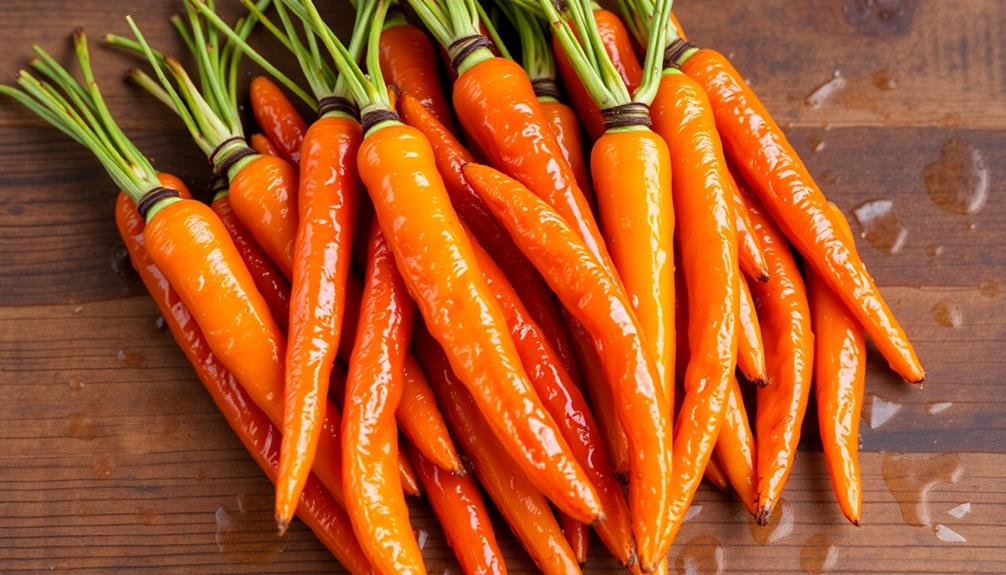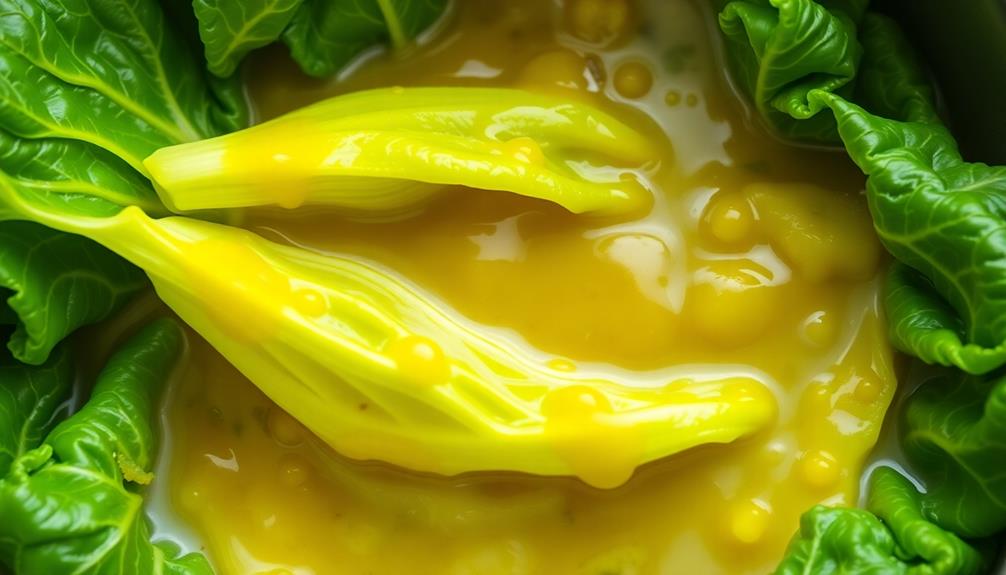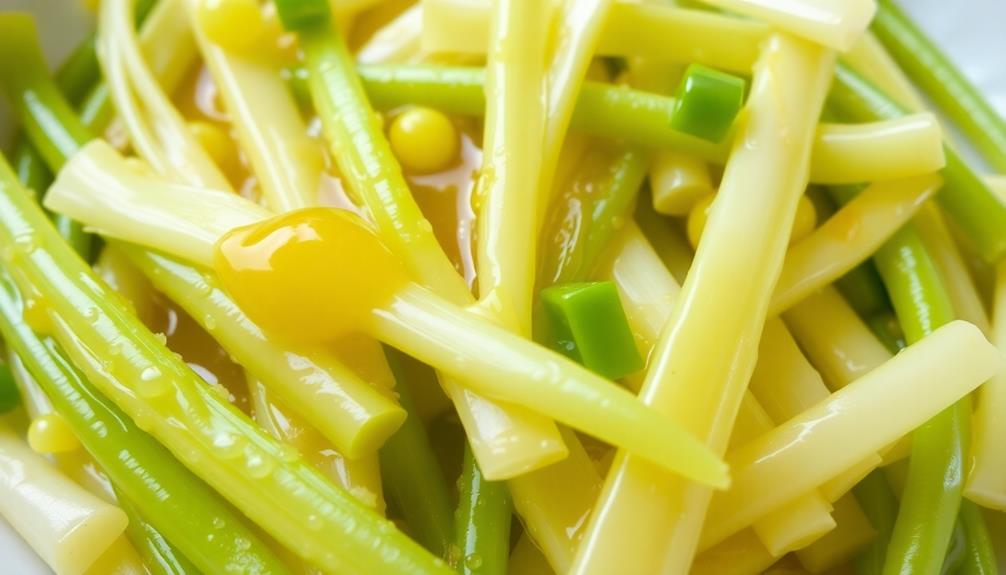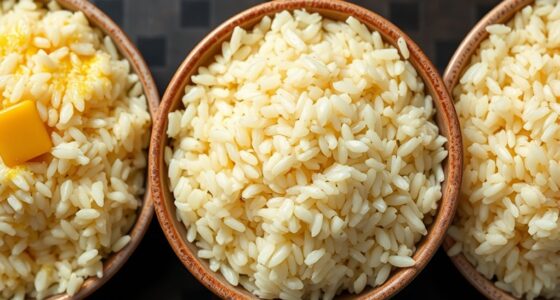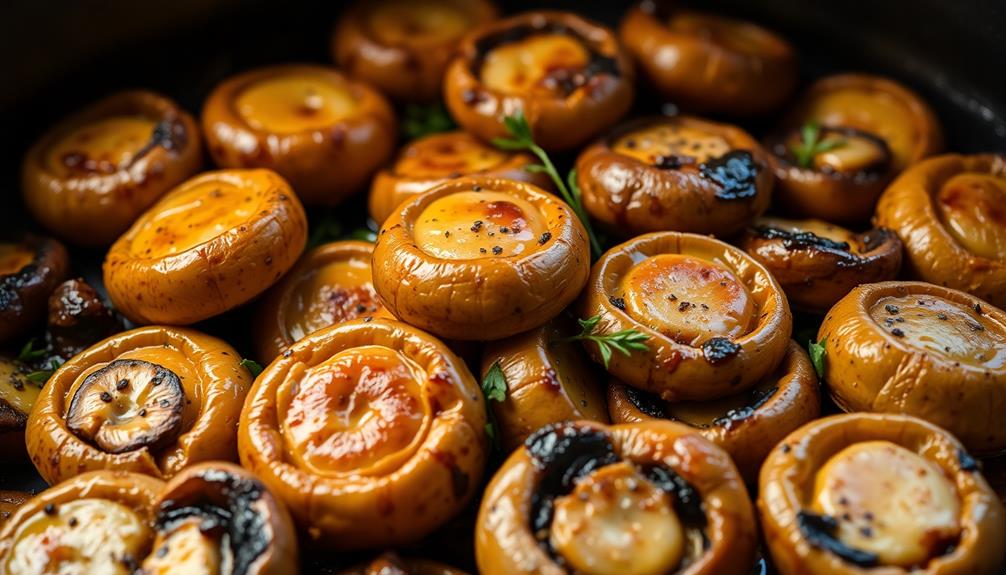You'll love the sweet, savory, and absolutely addictive flavor of butter-glazed carrots! Originating in the 1950s, this classic side dish has become a staple across America. The natural sweetness of carrots perfectly complements the rich creaminess of melted butter, creating a luxurious mouthfeel. Uniform slicing ensures even cooking, while a drizzle of honey adds caramelized goodness. Season with salt, pepper, and spices to your taste. Serve alongside your favorite main dishes for a colorful, nutritious addition that's sure to delight. Want to learn more about the history and cooking tips for this irresistible recipe?
Key Takeaways
- Butter-Glazed Carrots emerged in the 1950s as a new way to prepare carrots, enhancing their natural sweetness with a rich, creamy butter glaze.
- The recipe features uniformly sliced carrots cooked in melted butter, honey, and seasoning for a balanced sweet, savory, and indulgent flavor profile.
- High-quality butter, like grass-fed, elevates the dish's flavor and nutritional value, while versatile seasoning options allow for personal taste preferences.
- Butter-Glazed Carrots serve as an easy-to-prepare, versatile side dish that complements a variety of main courses, including meats, fish, and vegetarian options.
- Carrots are a nutritious vegetable, rich in vitamins and antioxidants, making Butter-Glazed Carrots a colorful and healthy addition to any meal.
History
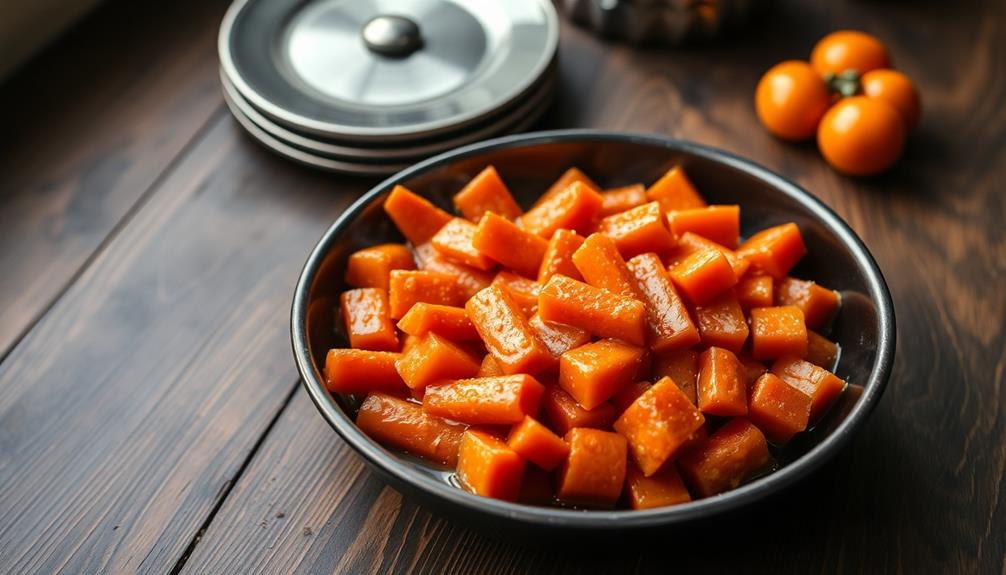
Though carrots have been a staple vegetable for centuries, the butter-glazed variety has a more recent history. It's believed this delightful dish first emerged in the 1950s when home cooks began experimenting with new ways to prepare the humble carrot.
By coating the vibrant orange veggie in a rich, velvety glaze made from butter, sugar, and a touch of seasoning, they transformed the ordinary into the extraordinary. The creamy texture of butter, influenced by its emulsification process, adds a luxurious mouthfeel that enhances the overall dish. Additionally, the use of butter's culinary versatility allows for a delightful balance of flavors.
The popularity of butter-glazed carrots quickly spread, becoming a staple on dinner tables across America. Families loved how the sweet-savory flavor paired perfectly with roasted meats and hearty main dishes.
Plus, the simple preparation made it an easy side that could be whipped up in no time. Today, this timeless recipe continues to delight taste buds, offering a comforting and delicious way to enjoy carrots.
Whether served at a holiday feast or an everyday meal, butter-glazed carrots always hit the spot.
Recipe
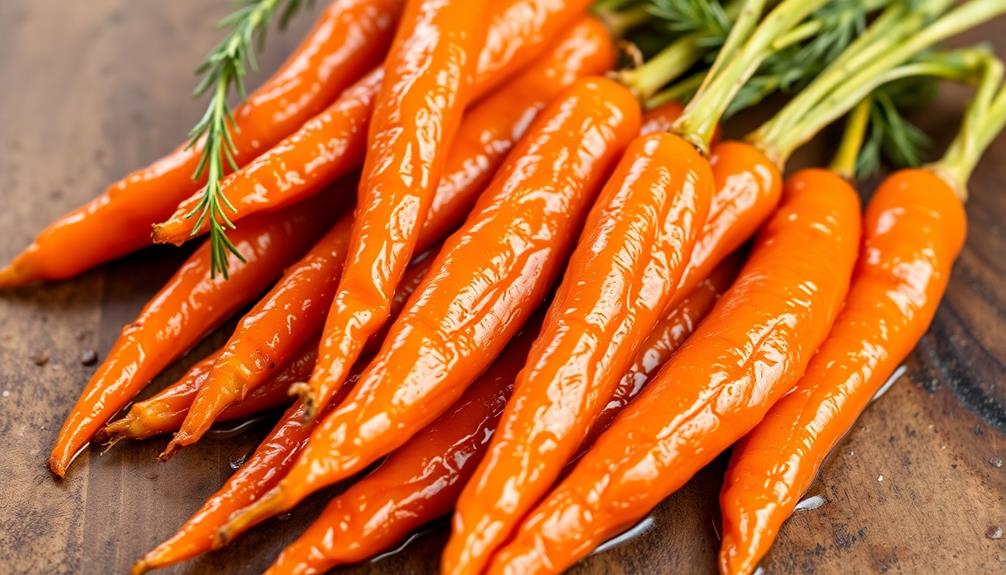
Butter-Glazed Carrots are a simple and delicious side dish that can elevate any meal. The natural sweetness of the carrots perfectly complements the rich, creamy butter, creating a harmonious flavor profile that's sure to delight your taste buds. For a truly exceptional flavor, consider using high-quality butter, such as grass-fed butter options, which can enhance both taste and nutrition.
One of the best things about this recipe is its versatility. Butter-Glazed Carrots can be served alongside a variety of main dishes, from roasted meats to grilled fish. They're also a great option for a vegetarian or vegan-friendly meal, providing a satisfying and nutritious accompaniment.
- 1 lb. carrots, peeled and sliced into 1/4-inch thick rounds
- 2 tbsp. unsalted butter
- 1 tbsp. honey (optional)
- Salt and pepper to taste
In a large skillet, melt the butter over medium heat. Add the sliced carrots and toss to coat them evenly in the butter. Cover the skillet and cook the carrots for 10-12 minutes, or until they're tender and easily pierced with a fork. Stir the carrots occasionally to ensure even cooking. If using honey, drizzle it over the carrots and toss to combine. Season with salt and pepper to taste.
When cooking Butter-Glazed Carrots, it's important to keep a close eye on the carrots to prevent them from overcooking and becoming mushy. Additionally, you can experiment with different herbs or spices to add even more flavor to the dish, such as fresh thyme, rosemary, or a pinch of ground cumin.
Enjoy your Butter-Glazed Carrots as a delightful side dish or a satisfying snack.
Cooking Steps

Peel and slice the carrots evenly, ensuring they cook at the same rate.
Melt the butter in a large skillet over medium heat, then add the carrots.
Cook the carrots, stirring occasionally, until they're tender and caramelized.
Step 1. Peel and Slice Carrots Evenly
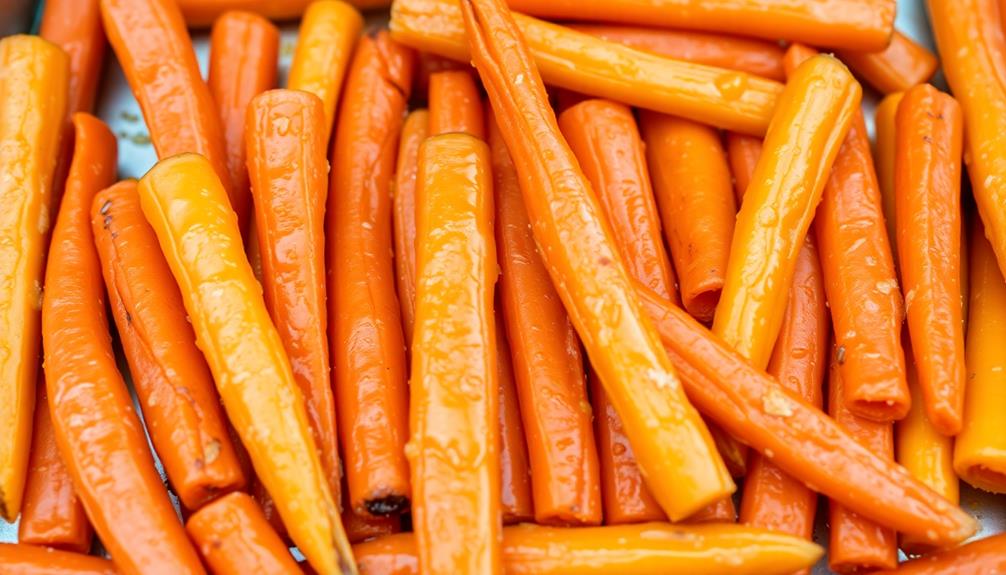
First, peel the carrots using a vegetable peeler or knife. Gently remove the outer skin, revealing the bright orange flesh underneath. Be careful not to waste too much of the carrot as you peel.
Next, grab a cutting board and a sharp knife. Slice the carrots into thin, even pieces, about 1/4-inch thick. This will help them cook evenly and ensure a consistent texture throughout the dish.
Try to make the slices as uniform as possible – this will give your carrots a polished, professional look. Run your knife through the pile a few times, checking for any stray thick or thin pieces. Adjust your slicing technique as needed until all the carrot coins are the same size.
With the carrots prepped, you're ready to move on to the next step in creating these butter-glazed beauties!
Step 2. Melt Butter in a Skillet

To begin the cooking process, melt the butter in a large skillet over medium heat. Watch as the golden nuggets of goodness slowly transform, bubbling and sizzling as they release their rich, creamy aroma.
Gently swirl the pan to ensure the butter melts evenly, coating the entire surface. As the butter liquefies, it will take on a slightly frothy appearance, signaling that it's now ready for the next step.
Be mindful not to let the butter burn – you want it to reach a golden-brown hue, not dark and bitter. The perfect butter melt should take approximately 2-3 minutes, filling your kitchen with the tantalizing scent of pure, unadulterated butter.
Once it reaches this stage, you can proceed to add your prepared carrots, ensuring they're fully coated in the silky, melted goodness. Get ready for the magic to happen as the carrots and butter unite, creating a harmonious blend of flavors that will have your taste buds dancing with delight.
Step 3. Add Carrots to Skillet
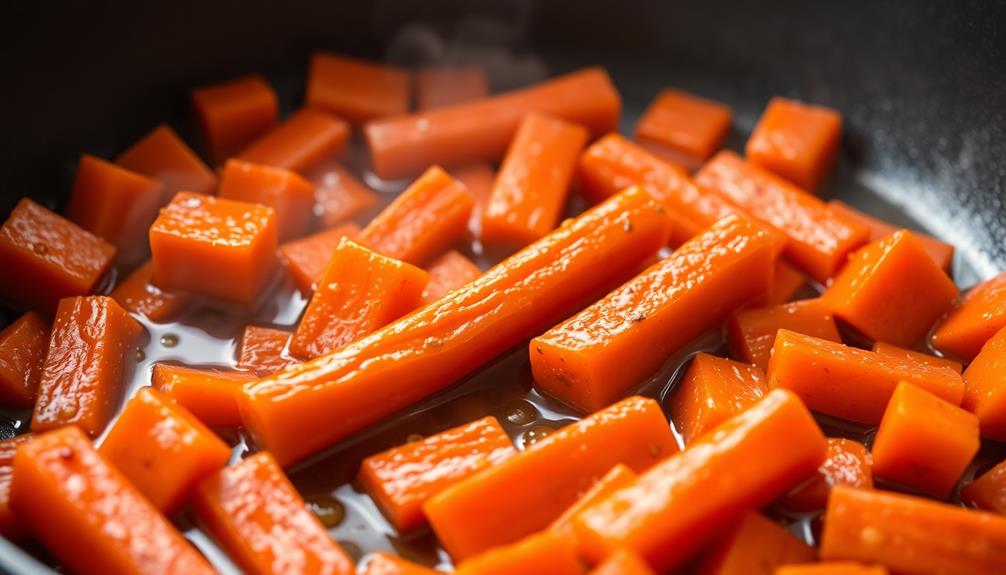
Once the butter has melted to perfection, go ahead and add your prepared carrots to the skillet.
Carefully place them in a single layer, ensuring they've plenty of room to sizzle and caramelize. You'll instantly notice the buttery aroma fill the air, tantalizing your senses.
As the carrots cook, they'll start to soften and take on a beautiful golden-orange hue. Give the skillet a gentle shake every now and then to promote even cooking.
The key is to let the carrots sear and develop a delightful caramelized crust on the edges, locking in all that natural sweetness.
After a few minutes, use a pair of tongs to gently toss the carrots, allowing the uncooked sides to get their turn in the hot butter.
Continue this process until the carrots are fork-tender and the glaze has thickened to your desired consistency.
Your kitchen will be filled with the irresistible fragrance of butter-glazed perfection.
Step 4. Cook Until Tender

With the carrots sizzling away in the buttery skillet, continue cooking them until they reach the perfect tenderness.
You'll know they're ready when you can easily pierce them with a fork, but they still retain a slight bite.
Gently stir the carrots occasionally, ensuring they cook evenly and soak up all that delicious, golden-hued glaze.
As the minutes tick by, the carrots will slowly become tender and the butter will melt into a rich, glossy coating.
Keep a close eye on them, adjusting the heat as needed to prevent burning.
The aroma will become more intense, filling your kitchen with the irresistible scent of caramelized vegetables.
Once the carrots have reached your desired level of doneness, remove the skillet from the heat.
Get ready to indulge in these luscious, butter-glazed carrots – they're about to become your new favorite side dish!
Step 5. Add Honey and Seasonings
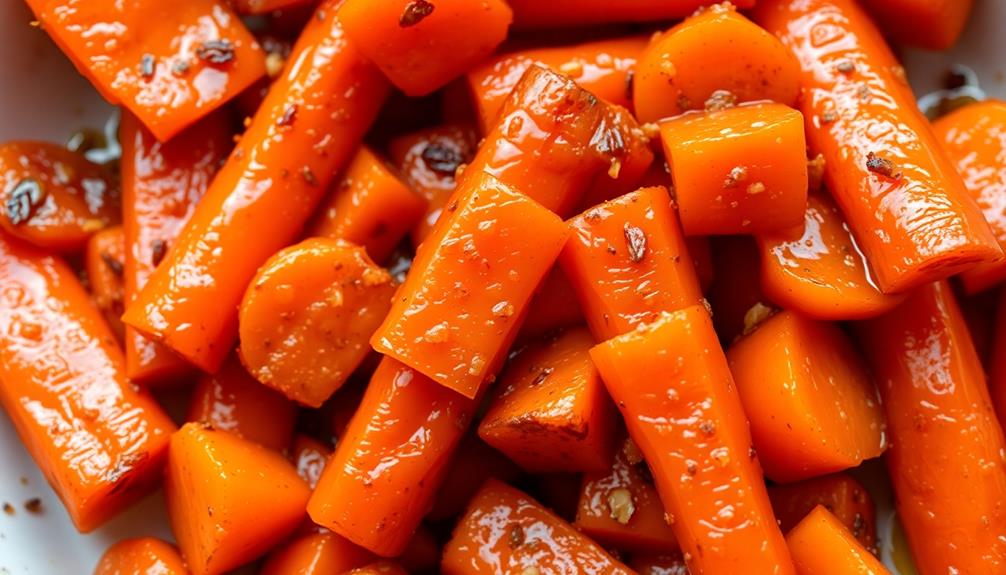
Add a touch of sweetness and flavor by drizzling in a bit of honey. This golden nectar will caramelize the carrots, creating a delightful glaze that clings to every bite.
Gently swirl the pan to ensure the honey coats the carrots evenly, allowing the natural sugars to caramelize and the aroma to fill the air. To complement this delicious dish, consider serving it alongside a warm cup of herbal tea for a soothing beverage experience.
Next, season the carrots with a pinch of salt and a dash of black pepper. The saltiness will balance the sweetness, while the pepper adds a subtle kick. You can also experiment with other spices, like a sprinkle of paprika or a pinch of dried thyme, to elevate the flavors.
Stir the carrots occasionally, letting the seasonings meld together and the glaze thicken slightly. The result will be tender, flavorful carrots that are impossible to resist.
Serve them hot, allowing the buttery, honey-kissed goodness to shine.
Final Thoughts
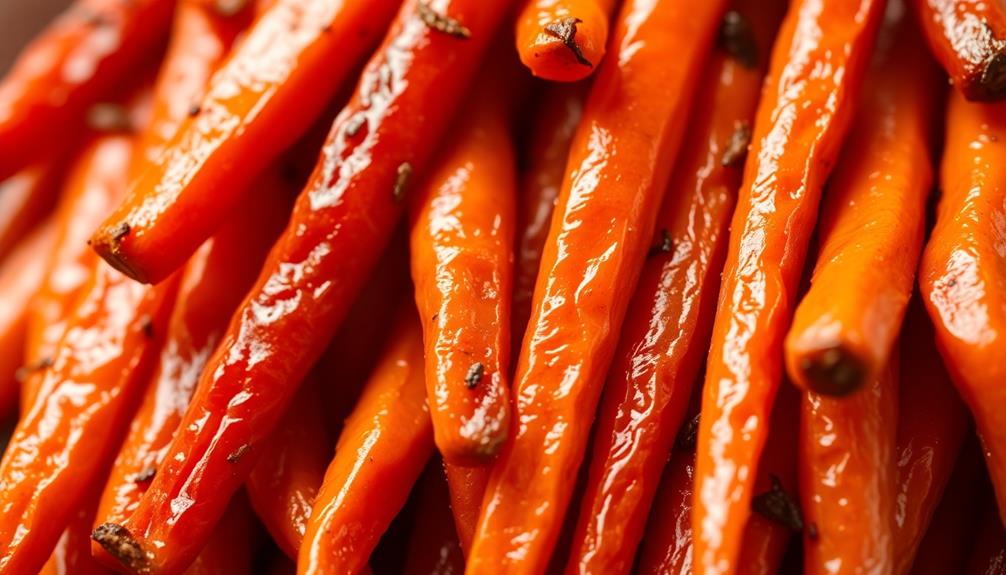
As you've now mastered the art of preparing these butter-glazed carrots, consider how this simple yet delicious dish can elevate your meals.
The combination of sweet, salty, and savory flavors creates a truly irresistible side that will have your family and guests clamoring for more. Imagine serving these glistening, vibrant carrots alongside a juicy roast chicken or hearty meatloaf – the perfect accompaniment to round out the meal.
Beyond their mouthwatering taste, these butter-glazed carrots are a breeze to make. The active preparation time is minimal, and the results are well worth the effort.
Plus, the recipe is easily adaptable to suit your preferences, whether you prefer a touch more sweetness or a hint of spice. Experiment with different seasonings and herbs to discover your own signature twist on this classic dish.
Frequently Asked Questions
Can I Use Frozen Carrots Instead of Fresh?
Yes, you can use frozen carrots instead of fresh. They'll cook up just as nicely, and you can skip the prep work. Just make sure to adjust the cooking time as needed to get that perfect tender-crisp texture.
How Long Do the Carrots Keep After Cooking?
Once cooked, the carrots will keep for 3-4 days in the refrigerator. Store them in an airtight container, and they'll maintain their sweet, savory flavor and tender texture. Enjoy them within a few days for best results.
Can I Make This Dish Ahead of Time?
Yes, you can make this dish ahead of time. The carrots will keep for 3-4 days in the refrigerator after cooking. Just reheat them gently before serving to maintain their tender, glazed texture.
What Is the Best Way to Reheat the Carrots?
The best way to reheat the carrots is to place them in a skillet over medium heat, adding a bit of butter or oil to prevent them from drying out. Stir frequently until heated through, about 5-7 minutes.
Can I Add Other Vegetables to the Recipe?
You absolutely can add other vegetables to this recipe! Feel free to experiment with ingredients like Brussels sprouts, parsnips, or even tiny potatoes. Just adjust the cooking time as needed to ensure they all reach the perfect tenderness.
